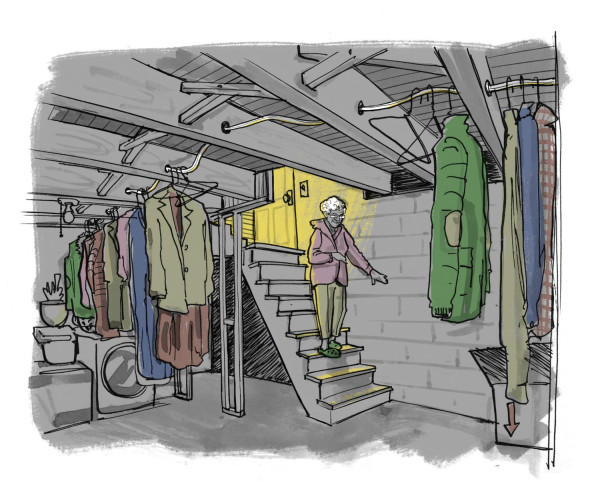“My mother-in-law is an active 83-year-old who still lives in her own home of many years. When we last visited, we were horrified to discover that she has hung a collection of disused and out-of-season clothing on Romex electrical cable, which runs through the joists under the basement ceiling. Now we’re worried about other safety issues down there, too.” —Anthony (and Julia) Wisniewski
“When we last visited, we were horrified to discover that she has hung a collection of disused and out-of-season clothing on Romex electrical cable, which runs through the joists under the basement ceiling.” Brent Affrunti
The Fix
Hanging anything from active wiring is a fire hazard and a big no-no. The weight of heavy items of clothing can loosen or dislodge the wiring, and wire hangers could abrade the plastic covering on the electrical wire—potentially causing a shock,
or, more ominously, leading to a fire.
To avoid the temptation, you could enclose the open joists with a ceiling. A simpler solution, though, would be to install clothing rods. For each, you’ll need a 6′ length of dowel (1 1/4″thick), two 2″-long eyebolts with nuts, medium-weight utility chain, and two 3″ screw hooks.
First, place the screw hooks. They should be centered on a joist, no more than 68″ apart. Drill holes and screw them in. Carefully measure the distance between them, and use this measurement to mark and drill holes for the bolt hooks in the rod. You want the eye bolts to line up vertically with the screw hooks and be at least 2″ from the ends of the rod on either side.
Once the marks are placed on the rod, drill holes slightly larger than the eyebolts, all the way through the dowel. Insert the eyebolts so that the ends protrude through the dowel, then secure with the nuts. Finally, cut utility chain to the desired length (away from the ceiling), using wire cutters. Loop the chain through the eyebolts and suspend it on either
end from the screw hooks.
Your concerns about safety issues elsewhere in the basement are well founded. You don’t have to be an octogenarian to trip or fall on a staircase, particularly the common scenario of rough basement stairs: built without a handrail, with shallow treads and uneven riser heights. Remedy any stair hazards immediately. Make sure there’s a working light switch at the top and the bottom of the stairs, too.
What have you, your spouse, pet, contractor, previous owner (you get the picture) screwed up? Email us at lviator@aimmedia.com.







